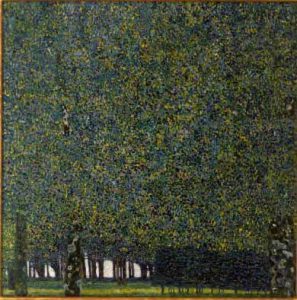Posted on February 20, 2017 in Arts & culture.
Gardens Exhibition at the Grand Palais from March 18 to July 23, 2017

Gustave Klimt, Le Parc, 1910 or before, oil on canvas, 110,4 x 110,4 cm, USA, New York, © The Museum of Modern Art, Gertrud A. Mellon Fund, 1957
150 years after the publication of Arthur Mangin's founding work, Les Jardins: histoire et description and forty years after the decisive exhibition of the National Fund for Historical Monuments and Sites in 1977, Jardins, 1760-1820. Land of illusion, land of experience, the craze aroused by green heritage in France is unabated, with today 22 parks and gardens of historical, botanical or landscaped interest, of which nearly 000 are registered or classified as historical monuments.
Jardins, whose title is intended to soberly reflect all the diversity of the subject, considers both the history of the art of gardens and the history of exhibitions on this theme, which has rarely attracted the attention of cultural institutions. . If its presence in the museum seems founded on a contradiction - the garden, a living monument, by nature changing, ephemeral and in situ, is it not the object par excellence of an impossible exhibition? - the links between the museum and the garden are indeed close. Places of knowledge and pleasure, which are born, grow and die, they are also a space that the visitor can walk at his own pace.
The subject is studied in its essential definition: as an enclosure, a delimited entity within a territory, a staged space and therefore a mirror of the world. Presented in the National Galleries of the Grand Palais, this multidisciplinary gathering of paintings, sculptures, photographs, drawings, films, etc., is neither a complete history of the art of gardens, nor an inventory that would claim to completeness. Related notions, such as that of nature, will be kept away from a statement firmly centered on its subject but which nevertheless intends to show, as in a large collage, the garden as a total work of art, which awakens all the senses. , and ask the essential question of representation. The thematic route, where the history of art and that of the sciences intertwine, is built like a walk where the “real” garden - neither literary, nor symbolic, nor philosophical - is understood both as a botanical and artistic construction. This “gardener” exhibition, a word from Horace Walpole taken up by Jean-Claude-Nicolas Forestier, intends to defend the garden as a form of art and its creators as artists.
Jardins focuses on experiments carried out in Europe - and more particularly in France - from the Renaissance to the present day. If the medieval garden is often the starting point for the great panoramas of the discipline, the history of art like that of botany invite to privilege another beginning. During the Renaissance, scholars and artists inspired by a new critical approach reread ancient sources - illustrated by the inaugural presence, within the exhibition, of a fresco from the House of the Golden Bracelet in Pompeii - at the light from careful observation of the plant. These reinterpretations, accompanied by real artistic revolutions embodied by the extraordinary drawings of Albrecht Dürer, also lead to the creation in Padua (1545) of the first botanical garden. If plants are still cultivated there for their utilitarian role, their gathering now also has a demonstration vocation and serves as a support for scientific education. The medieval hortus conclusus breaks and opens up to the world, with gardens enriched by the discoveries of the great explorers; it also opens up to the landscape, enters the field of the arts and becomes a real pictorial project for artists who have, notably thanks to perspective, new and revolutionary tools of representation.
From Albrecht Dürer's small tuft of grass to Gilles Clément's “planetary garden”, the sets of scales are a common thread of this course. The visit begins with the earth, a prelude to a vast ensemble that highlights the primary elements and the vocabulary of gardens. A selection of works in various formats and materials evokes these essential components. Soil samples, flowers and fruits in glass and plaster, gardeners' tools, will be the subject of a dense display resembling a cabinet of curiosities. The herbarium, understood as a dry garden, will be at the heart of this first ensemble placed under the sign of the unexpected.
This vocabulary gradually gives way to syntax. Whether broken down, analyzed, represented or imagined, the garden is always thought of in relation to a figure whose presence punctuates the entire course: that of the gardener. Painted, sculpted, photographed, the latter is in the spotlight, from the first sketches to the tools of daily work. The time of the conception is approached thanks to a gathering of drawings and plans. The presentation of chronological developments is punctuated by moments conducive to meditation, such as around the Acanthes by Matisse who speaks of his cut-out gouaches like an art that is built like a "small garden".
Gardens, like museums, are the place of all time - long time, short time, alternating seasons or eternity. Seen from a bird's eye view, gathering places, from the large royal estate to the public park, they are shown in their collective dimension, evoked through the history of their forms and uses. Places of celebration and love, of melancholy and destruction, subject to changes in fashions and sometimes abandoned, they are the subject of intense cultural transfers and are, par excellence, an art form marked by the ambivalence and the passage of time.
Within this story, several highlights are privileged. The XNUMXth century, embodied in the exhibition by Fragonard's masterpiece, La Fête à Saint-Cloud, occupies an essential place in the course. Likewise, the turning point of the XNUMXth and XNUMXth centuries, when representing the garden became, for artists, a means of better understanding the contours of a changing world and of exploring the plastic vocabulary of modernity, constitutes a key moment in this work. history.
A walk that brings together some of the greatest representations of gardens from this period offers the visitor an immersive journey through paintings without people. The stroll, which takes place alternately in spaces frozen by the artists, captures of images of gardens at the moment t, and in sets marked by the feeling of the passage of time, metaphorically spares the visitor groves and great perspectives. The scenographic work of the exhibition, in reverse of a literal approach, plays with framing and games of scales, arranging surprises - like ha-ha - for the visitor to transpose, within the exhibition route, the outlines of a promenade.
From the earth to the planetary garden, the route takes height and ends with the image, still to be defined, of the garden of tomorrow and the new artistic, botanical and social paradigms that shape it. The exhibition intends to honor those who, especially in France, have for more than thirty years constituted an exceptional generation: gardeners, landscapers, authors of new initiatives where the garden is worked for its ecological and social use, participate in this gathering which also intends to combine knowledge and delight. In comparison, 80 photographs presented from March 18 to July 23, 2017 on the gates of the Jardin du Luxembourg will testify, on the one hand, to the heritage interest of the garden through the great names of photography and, on the other hand, to its artistic value through the lens of photographer Jean-Baptiste Leroux, recognized for his work on gardens labeled "Remarkable Garden". At the end of the “Extraordinary Gardens” competition launched by the Rmn-Grand Palais on the Wipplay platform in summer 2016, three winners will also see their photographs printed in large format on the grids.
Pratical information
- Commissioner: Laurent Le Bon, general heritage curator, president of the Musée national Picasso, Paris
- associate commissioners: Marc Jeanson, head of the National Herbarium of the National Museum of Natural History;
- Colin Zellal, heritage curator
- scenography: Laurence Fontaine
- opening : Sunday, Monday and Thursday from 10 a.m. to 20 p.m .; Wednesday, Friday and Saturday from 10 a.m. to 22 p.m .; weekly closing on Tuesday
- prices: 13 €, TR 9 € (16-25 years old, job seekers and large family), free for children under 16, beneficiaries of social minima
- access: metro line 1 and 13 "Champs-Elysées-Clemenceau" or line 9 "Franklin D. Rossevelt)
- information and reservations: www.grandpalais.fr
Drawing Now Art Fair: Tatiana Wolska winner 2024
The invention of language by Gertrude Stein and Pablo Picasso
The history of French women's golf at Golf du Sorbier








